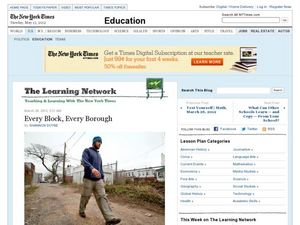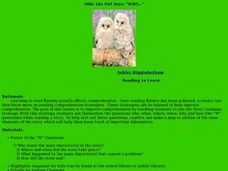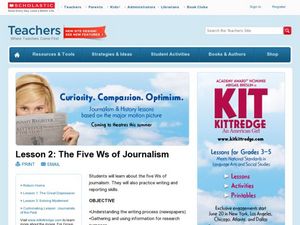Student Handouts
The Five W's and How
Here is a great graphic organizer for ensuring that young researchers and writers cover all their bases when brainstorming a topic by considering the five W's (who, what, where, when, and why) and how.
Curated OER
The 5 W's
Examine how to answer who, what, when, where, and why when reading text. Young writers listen to the story Skeleton Hiccups, and as a class answer and discuss the five W's. Independently they read the story silently, and write the...
Curated OER
"Every Block, Every Borough"
From the New York Times Learning Network series, this worksheet poses 10 questions on an article entitled, "Leaving His Footprint on the City" about a man planning to walk every street in all five New York boroughs. The prompts address...
Curated OER
Ollie the Own Says: WHO
Scholars examine the strategy of making a story map or outline to identify the main elements of a story. They discuss the who, what, where, when, why, and how of a story, in an outline form. As a class they read a short story, answer the...
Curated OER
Comprehending Through Questioning
Elementary schoolers observe and apply a variety of reading comprehension strategies. They silently read a passage out of their science textbook, and discuss answering the who, what, where, when, and how of the text. In small groups they...
Curated OER
The Five W's of Tax Day
Use April 15th to teach your students the fundamentals of the American federal tax system.
Curated OER
The 5 W's of Reading
Primary students will use the five "W" questions for reading comprehension as they read silently to themselves so that they can understand and remember what they have read. They then read The Velveteen Rabbit aloud, discussing the five...
Curated OER
"It's All About Grandma Chic": Reading Informational Text
This New York Times "Learning Network" exercise on reading informational text poses 6 questions about a high-interest article on teen fashion. The article meant to be review with is resource, "More than meets the iPhone Lens", is rather...
Curated OER
Summarizing with James and the Giant Peach
Elementary readers in literature groups practice summarizing chapter-by-chapter with Roald Dahl's James and the Giant Peach. Focus on main idea, supporting details, and the 5 Ws. Unfortunately, a clever "peach" graphic organizer to which...
Curated OER
Question words, question marks
Practice the five W's and question marks with a fun grammar worksheet. After copying the words who, what, where, when, why, and how, kindergartners fill the words into various questions. For extra practice, have kids come up with their...
Alabama Learning Exchange
Who, What, When, Where, Why, How?
Your youngsters are just starting to read texts and pull out important information. Use this graphic organizer with any text to help them practice identifying the who, what, when, where, why, and how of a text. Although the format of the...
Curated OER
5 W Questions
Second graders practice asking the 5 W questions by reading a Boxcar Children book. In this journalism lesson, 2nd graders read a single story from the Boxcar Children series and answer the 5 W's about each specific chapter. Students...
Curated OER
Creative Problem Solving: Using the 5 W's (Who, What, Where, When, Why)
Third graders assimilate the use of the 5 W's (Who, What, Where, When, Why) when solving problems that are presented in literature and in real life situations. They use common fairy tales to solve problems that might arise at home or...
Curated OER
Writing Exercises: Imperialism I
Examine the impact of Imperialism in relation to power and industrialization. There are three short answer questions for critical thinkers to respond to in this handout. They'll describe the relationship between Imperialism and...
Curated OER
Writing Exercise: Nationalism Around the World II
Think about Nationalism and how it has influenced countries and colonialism all over the world. This worksheet gives learners the opportunity to compose three well-written answers describing the unification of Italy, Otto Von Bismarck,...
Curated OER
Writing Exercise: Economic and Social Revolutions II
The Industrial Revolution continues today in some parts of the world, and it's up to your class to think about why that is true. They compose three short answers related to socialism, industry, and the postindustrial economy. A great...
Curated OER
Writing Exercises: World War I, #1
After learning all about World War I, middle schoolers can delve into this writing exercise. They complete three short answer questions that ask them to describe the role of women in WWI, the role of technology in WWI, and four causes of...
Curated OER
The Five Ws of Journalism
Students write a mock article. In this journalism lesson, students define the word "article" and learn the five W's of article writing. Students complete a worksheet and write a paragraph using what they have learned.
Curated OER
Build Masters: Identifying Details
Find key details in books using this note card strategy. Each reader gets six cards with the classic who, what, where, when, why, and how detail prompts. After they read the book, they choose a card and locate a key detail answering the...
Curated OER
Preparing for Passover
Informational texts come in all shapes and sizes. Your kids will read the New York Times article, "Preparing for Passover" then answer seven comprehension questions. The answer to each question is located in embedded hyperlinks.
Curated OER
Hip-Hop History and the Beastie Boys
So what about those Beastie Boys? Kids read a New York Times article relating the history of hip-hop and rap icons the Beastie Boys. They then answer eleven who, what, when, where, and why questions about the text they read.
Curated OER
The Waste-Free Lunch
Reusable packaging for school lunches seems like a wonderful and eco-friendly idea; however, some children are being chastised for not following one school's guidelines. This New York Times article engages learners in reading...
Curated OER
Pass This Jobs Bill
It seems that print media is slowly being replaced by electronic versions. Get your kids reading the New York Times e-style. They'll read the provided article entitled, "Pass This Jobs Bill" then answer six comprehension questions. Two...
Curated OER
Cute, Colored and Contentious
Whether your class responds to the blog linked to this article, or just answers the nine related questions, they're in for an eye-opening read. Pupils consider animal rights as they read a New York Times article about two men who have...

























